Literature Review: Business Level Strategy in Strategic Management
VerifiedAdded on 2020/04/07
|12
|3134
|190
Report
AI Summary
This report provides a literature review on business level strategies within strategic management. It explores various strategies including cost leadership, differentiation, focused low cost, focused differentiation, and integrated cost leadership/differentiation. The report references Michael Porter's work on competitive advantage and the application of the Porter's five forces model. It discusses how organizations can use these strategies to gain a competitive edge, achieve market sustainability, and respond to market changes. The evolution of strategic management models from budgetary planning to strategic innovation and simplification is also examined. The report emphasizes the importance of strategic thinking, innovation, and effective execution in achieving business objectives and maintaining a sustainable position in the target market. The report aims to provide a comprehensive overview of business-level strategies and their application in the modern business environment.
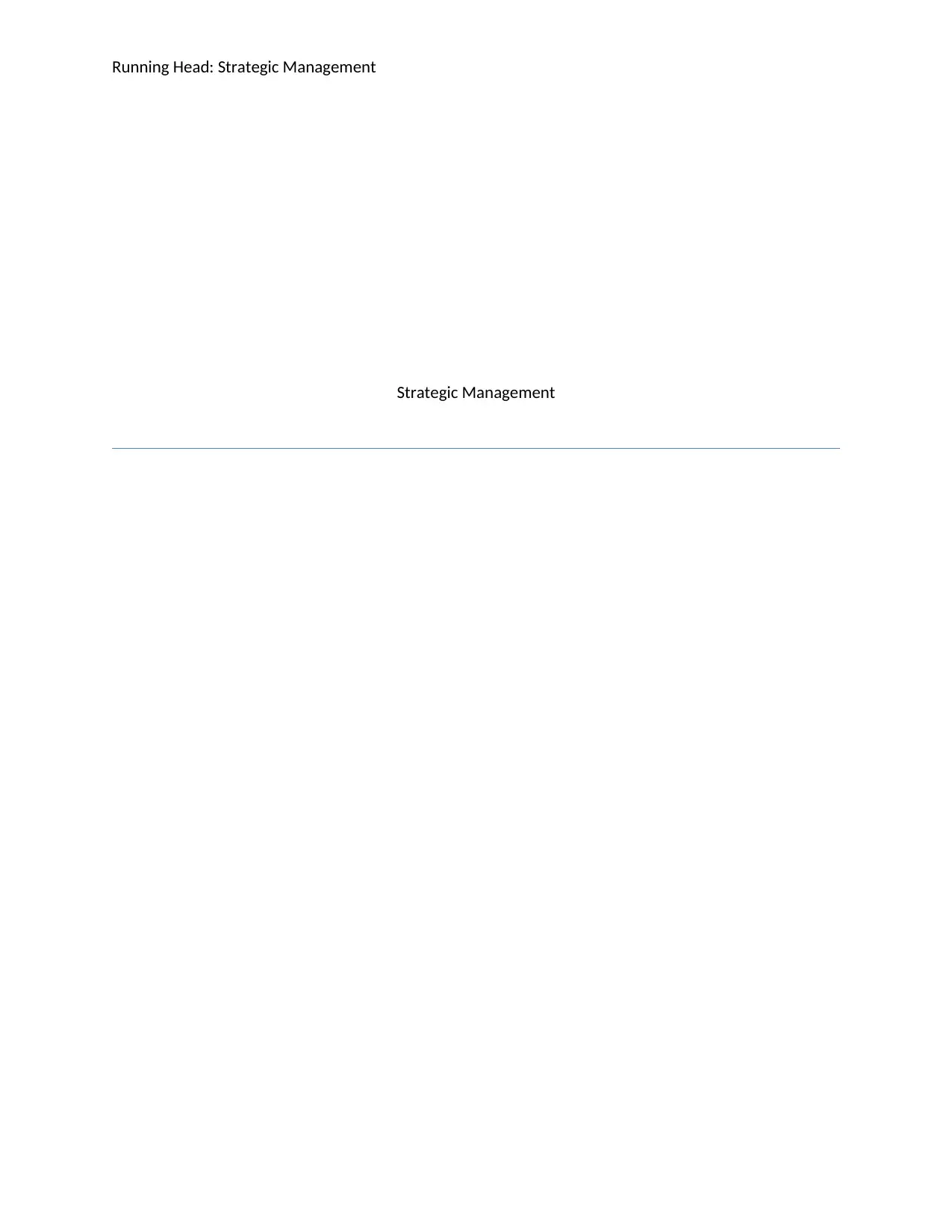
Running Head: Strategic Management
Strategic Management
Strategic Management
Paraphrase This Document
Need a fresh take? Get an instant paraphrase of this document with our AI Paraphraser
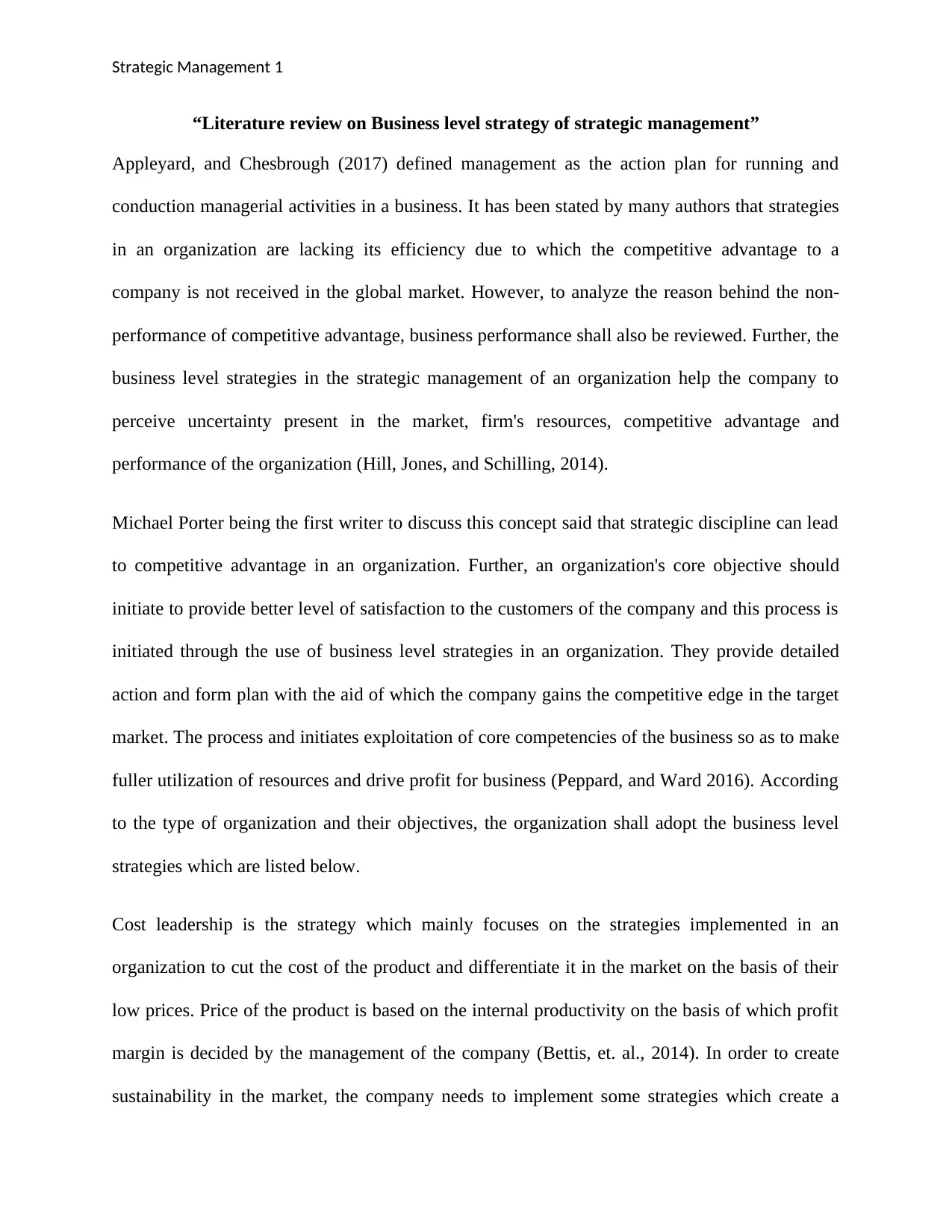
Strategic Management 1
“Literature review on Business level strategy of strategic management”
Appleyard, and Chesbrough (2017) defined management as the action plan for running and
conduction managerial activities in a business. It has been stated by many authors that strategies
in an organization are lacking its efficiency due to which the competitive advantage to a
company is not received in the global market. However, to analyze the reason behind the non-
performance of competitive advantage, business performance shall also be reviewed. Further, the
business level strategies in the strategic management of an organization help the company to
perceive uncertainty present in the market, firm's resources, competitive advantage and
performance of the organization (Hill, Jones, and Schilling, 2014).
Michael Porter being the first writer to discuss this concept said that strategic discipline can lead
to competitive advantage in an organization. Further, an organization's core objective should
initiate to provide better level of satisfaction to the customers of the company and this process is
initiated through the use of business level strategies in an organization. They provide detailed
action and form plan with the aid of which the company gains the competitive edge in the target
market. The process and initiates exploitation of core competencies of the business so as to make
fuller utilization of resources and drive profit for business (Peppard, and Ward 2016). According
to the type of organization and their objectives, the organization shall adopt the business level
strategies which are listed below.
Cost leadership is the strategy which mainly focuses on the strategies implemented in an
organization to cut the cost of the product and differentiate it in the market on the basis of their
low prices. Price of the product is based on the internal productivity on the basis of which profit
margin is decided by the management of the company (Bettis, et. al., 2014). In order to create
sustainability in the market, the company needs to implement some strategies which create a
“Literature review on Business level strategy of strategic management”
Appleyard, and Chesbrough (2017) defined management as the action plan for running and
conduction managerial activities in a business. It has been stated by many authors that strategies
in an organization are lacking its efficiency due to which the competitive advantage to a
company is not received in the global market. However, to analyze the reason behind the non-
performance of competitive advantage, business performance shall also be reviewed. Further, the
business level strategies in the strategic management of an organization help the company to
perceive uncertainty present in the market, firm's resources, competitive advantage and
performance of the organization (Hill, Jones, and Schilling, 2014).
Michael Porter being the first writer to discuss this concept said that strategic discipline can lead
to competitive advantage in an organization. Further, an organization's core objective should
initiate to provide better level of satisfaction to the customers of the company and this process is
initiated through the use of business level strategies in an organization. They provide detailed
action and form plan with the aid of which the company gains the competitive edge in the target
market. The process and initiates exploitation of core competencies of the business so as to make
fuller utilization of resources and drive profit for business (Peppard, and Ward 2016). According
to the type of organization and their objectives, the organization shall adopt the business level
strategies which are listed below.
Cost leadership is the strategy which mainly focuses on the strategies implemented in an
organization to cut the cost of the product and differentiate it in the market on the basis of their
low prices. Price of the product is based on the internal productivity on the basis of which profit
margin is decided by the management of the company (Bettis, et. al., 2014). In order to create
sustainability in the market, the company needs to implement some strategies which create a
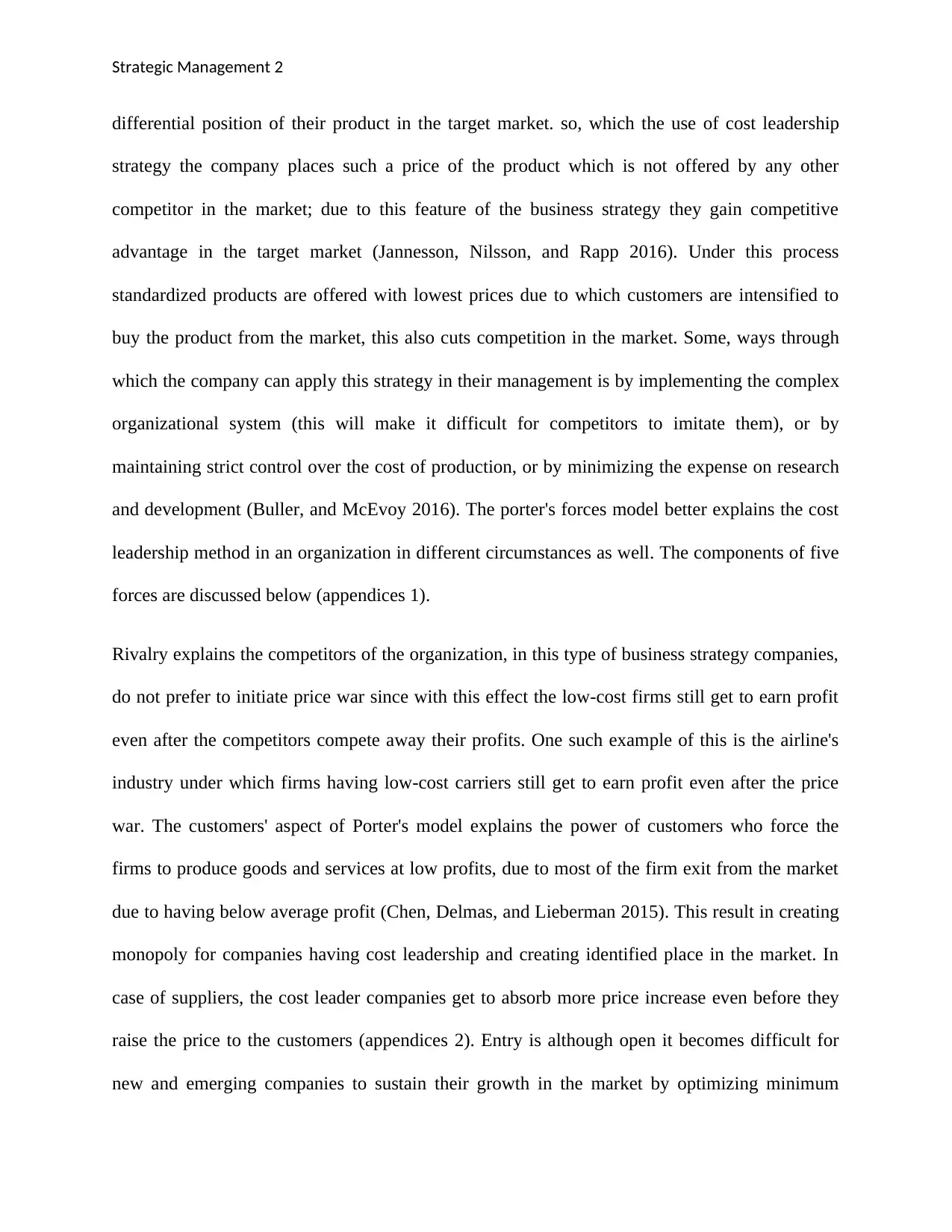
Strategic Management 2
differential position of their product in the target market. so, which the use of cost leadership
strategy the company places such a price of the product which is not offered by any other
competitor in the market; due to this feature of the business strategy they gain competitive
advantage in the target market (Jannesson, Nilsson, and Rapp 2016). Under this process
standardized products are offered with lowest prices due to which customers are intensified to
buy the product from the market, this also cuts competition in the market. Some, ways through
which the company can apply this strategy in their management is by implementing the complex
organizational system (this will make it difficult for competitors to imitate them), or by
maintaining strict control over the cost of production, or by minimizing the expense on research
and development (Buller, and McEvoy 2016). The porter's forces model better explains the cost
leadership method in an organization in different circumstances as well. The components of five
forces are discussed below (appendices 1).
Rivalry explains the competitors of the organization, in this type of business strategy companies,
do not prefer to initiate price war since with this effect the low-cost firms still get to earn profit
even after the competitors compete away their profits. One such example of this is the airline's
industry under which firms having low-cost carriers still get to earn profit even after the price
war. The customers' aspect of Porter's model explains the power of customers who force the
firms to produce goods and services at low profits, due to most of the firm exit from the market
due to having below average profit (Chen, Delmas, and Lieberman 2015). This result in creating
monopoly for companies having cost leadership and creating identified place in the market. In
case of suppliers, the cost leader companies get to absorb more price increase even before they
raise the price to the customers (appendices 2). Entry is although open it becomes difficult for
new and emerging companies to sustain their growth in the market by optimizing minimum
differential position of their product in the target market. so, which the use of cost leadership
strategy the company places such a price of the product which is not offered by any other
competitor in the market; due to this feature of the business strategy they gain competitive
advantage in the target market (Jannesson, Nilsson, and Rapp 2016). Under this process
standardized products are offered with lowest prices due to which customers are intensified to
buy the product from the market, this also cuts competition in the market. Some, ways through
which the company can apply this strategy in their management is by implementing the complex
organizational system (this will make it difficult for competitors to imitate them), or by
maintaining strict control over the cost of production, or by minimizing the expense on research
and development (Buller, and McEvoy 2016). The porter's forces model better explains the cost
leadership method in an organization in different circumstances as well. The components of five
forces are discussed below (appendices 1).
Rivalry explains the competitors of the organization, in this type of business strategy companies,
do not prefer to initiate price war since with this effect the low-cost firms still get to earn profit
even after the competitors compete away their profits. One such example of this is the airline's
industry under which firms having low-cost carriers still get to earn profit even after the price
war. The customers' aspect of Porter's model explains the power of customers who force the
firms to produce goods and services at low profits, due to most of the firm exit from the market
due to having below average profit (Chen, Delmas, and Lieberman 2015). This result in creating
monopoly for companies having cost leadership and creating identified place in the market. In
case of suppliers, the cost leader companies get to absorb more price increase even before they
raise the price to the customers (appendices 2). Entry is although open it becomes difficult for
new and emerging companies to sustain their growth in the market by optimizing minimum
⊘ This is a preview!⊘
Do you want full access?
Subscribe today to unlock all pages.

Trusted by 1+ million students worldwide
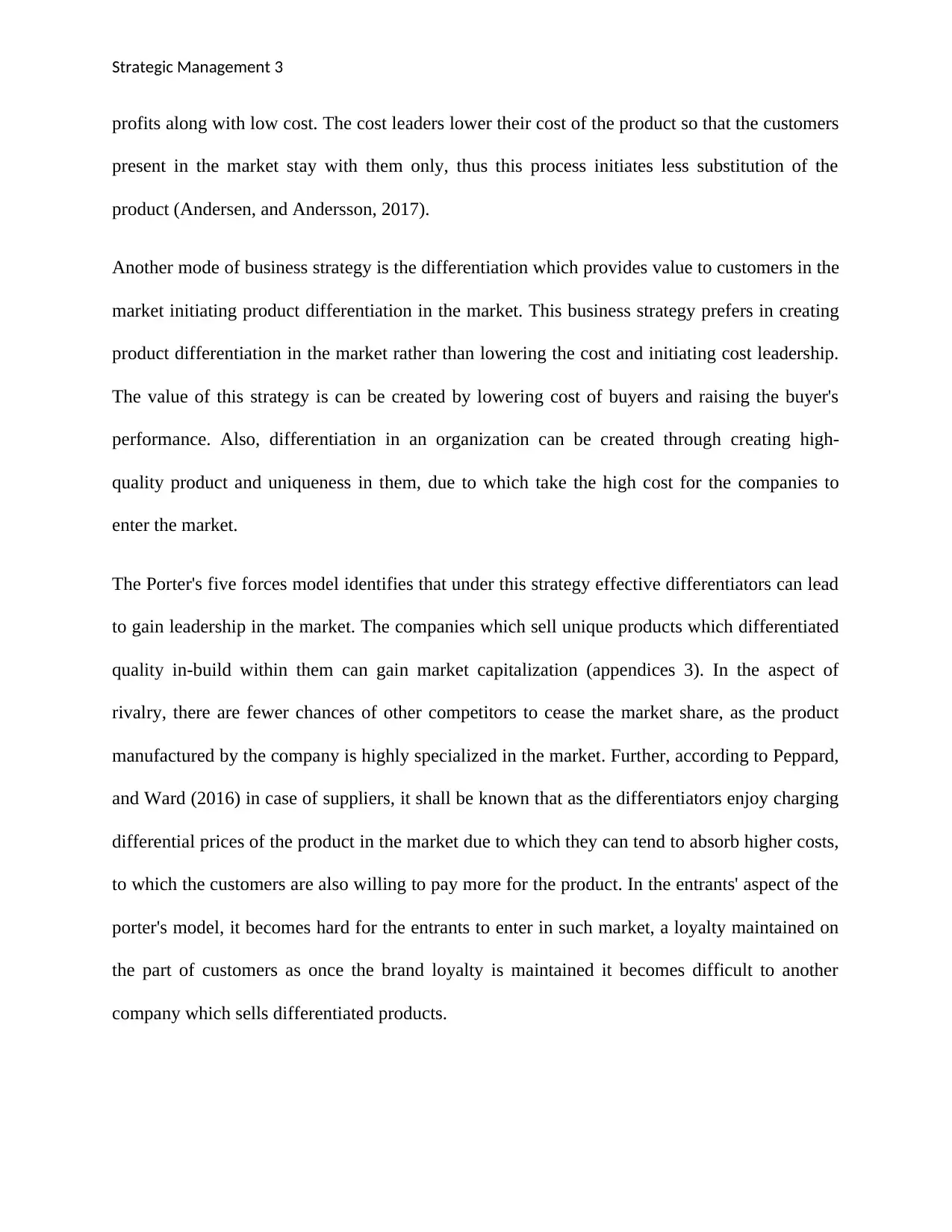
Strategic Management 3
profits along with low cost. The cost leaders lower their cost of the product so that the customers
present in the market stay with them only, thus this process initiates less substitution of the
product (Andersen, and Andersson, 2017).
Another mode of business strategy is the differentiation which provides value to customers in the
market initiating product differentiation in the market. This business strategy prefers in creating
product differentiation in the market rather than lowering the cost and initiating cost leadership.
The value of this strategy is can be created by lowering cost of buyers and raising the buyer's
performance. Also, differentiation in an organization can be created through creating high-
quality product and uniqueness in them, due to which take the high cost for the companies to
enter the market.
The Porter's five forces model identifies that under this strategy effective differentiators can lead
to gain leadership in the market. The companies which sell unique products which differentiated
quality in-build within them can gain market capitalization (appendices 3). In the aspect of
rivalry, there are fewer chances of other competitors to cease the market share, as the product
manufactured by the company is highly specialized in the market. Further, according to Peppard,
and Ward (2016) in case of suppliers, it shall be known that as the differentiators enjoy charging
differential prices of the product in the market due to which they can tend to absorb higher costs,
to which the customers are also willing to pay more for the product. In the entrants' aspect of the
porter's model, it becomes hard for the entrants to enter in such market, a loyalty maintained on
the part of customers as once the brand loyalty is maintained it becomes difficult to another
company which sells differentiated products.
profits along with low cost. The cost leaders lower their cost of the product so that the customers
present in the market stay with them only, thus this process initiates less substitution of the
product (Andersen, and Andersson, 2017).
Another mode of business strategy is the differentiation which provides value to customers in the
market initiating product differentiation in the market. This business strategy prefers in creating
product differentiation in the market rather than lowering the cost and initiating cost leadership.
The value of this strategy is can be created by lowering cost of buyers and raising the buyer's
performance. Also, differentiation in an organization can be created through creating high-
quality product and uniqueness in them, due to which take the high cost for the companies to
enter the market.
The Porter's five forces model identifies that under this strategy effective differentiators can lead
to gain leadership in the market. The companies which sell unique products which differentiated
quality in-build within them can gain market capitalization (appendices 3). In the aspect of
rivalry, there are fewer chances of other competitors to cease the market share, as the product
manufactured by the company is highly specialized in the market. Further, according to Peppard,
and Ward (2016) in case of suppliers, it shall be known that as the differentiators enjoy charging
differential prices of the product in the market due to which they can tend to absorb higher costs,
to which the customers are also willing to pay more for the product. In the entrants' aspect of the
porter's model, it becomes hard for the entrants to enter in such market, a loyalty maintained on
the part of customers as once the brand loyalty is maintained it becomes difficult to another
company which sells differentiated products.
Paraphrase This Document
Need a fresh take? Get an instant paraphrase of this document with our AI Paraphraser
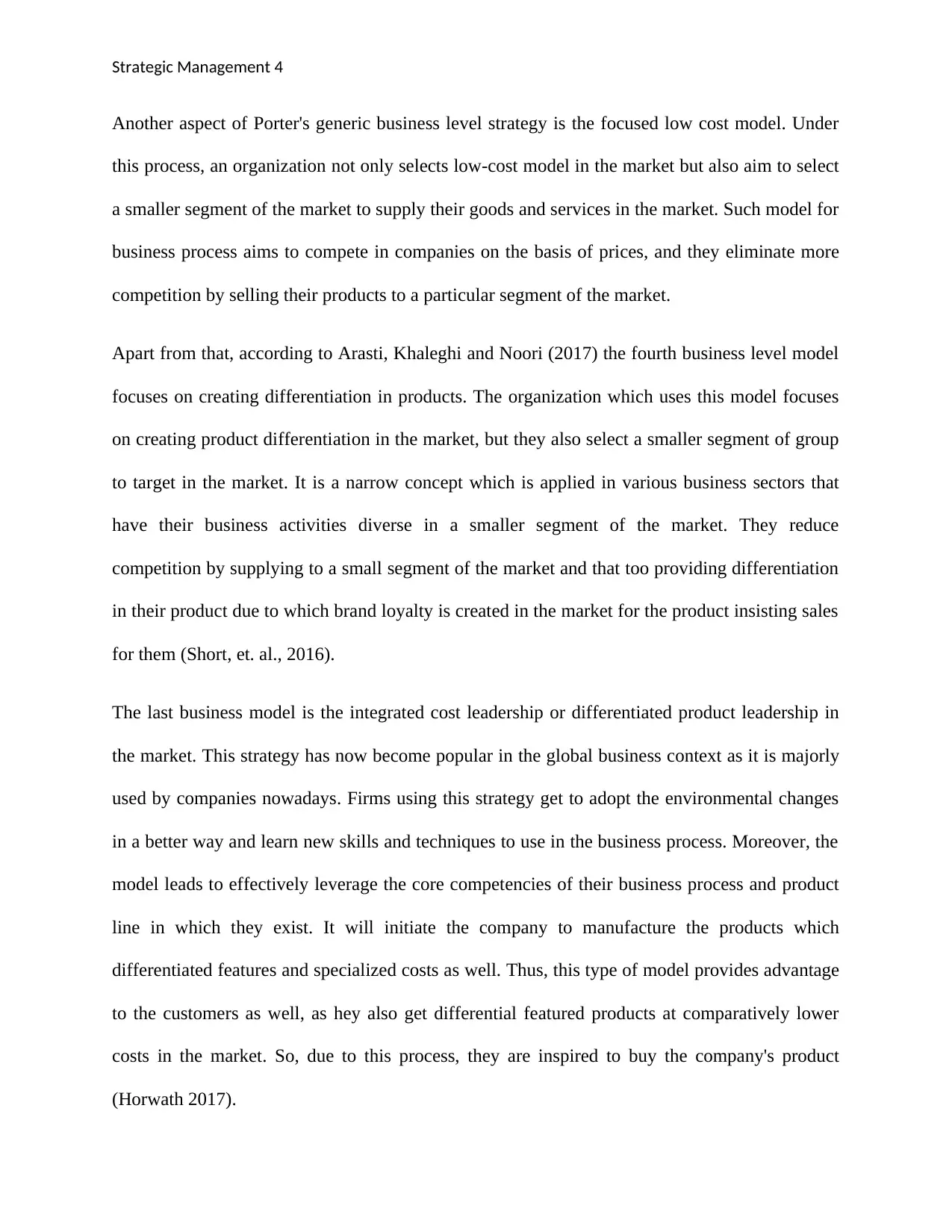
Strategic Management 4
Another aspect of Porter's generic business level strategy is the focused low cost model. Under
this process, an organization not only selects low-cost model in the market but also aim to select
a smaller segment of the market to supply their goods and services in the market. Such model for
business process aims to compete in companies on the basis of prices, and they eliminate more
competition by selling their products to a particular segment of the market.
Apart from that, according to Arasti, Khaleghi and Noori (2017) the fourth business level model
focuses on creating differentiation in products. The organization which uses this model focuses
on creating product differentiation in the market, but they also select a smaller segment of group
to target in the market. It is a narrow concept which is applied in various business sectors that
have their business activities diverse in a smaller segment of the market. They reduce
competition by supplying to a small segment of the market and that too providing differentiation
in their product due to which brand loyalty is created in the market for the product insisting sales
for them (Short, et. al., 2016).
The last business model is the integrated cost leadership or differentiated product leadership in
the market. This strategy has now become popular in the global business context as it is majorly
used by companies nowadays. Firms using this strategy get to adopt the environmental changes
in a better way and learn new skills and techniques to use in the business process. Moreover, the
model leads to effectively leverage the core competencies of their business process and product
line in which they exist. It will initiate the company to manufacture the products which
differentiated features and specialized costs as well. Thus, this type of model provides advantage
to the customers as well, as hey also get differential featured products at comparatively lower
costs in the market. So, due to this process, they are inspired to buy the company's product
(Horwath 2017).
Another aspect of Porter's generic business level strategy is the focused low cost model. Under
this process, an organization not only selects low-cost model in the market but also aim to select
a smaller segment of the market to supply their goods and services in the market. Such model for
business process aims to compete in companies on the basis of prices, and they eliminate more
competition by selling their products to a particular segment of the market.
Apart from that, according to Arasti, Khaleghi and Noori (2017) the fourth business level model
focuses on creating differentiation in products. The organization which uses this model focuses
on creating product differentiation in the market, but they also select a smaller segment of group
to target in the market. It is a narrow concept which is applied in various business sectors that
have their business activities diverse in a smaller segment of the market. They reduce
competition by supplying to a small segment of the market and that too providing differentiation
in their product due to which brand loyalty is created in the market for the product insisting sales
for them (Short, et. al., 2016).
The last business model is the integrated cost leadership or differentiated product leadership in
the market. This strategy has now become popular in the global business context as it is majorly
used by companies nowadays. Firms using this strategy get to adopt the environmental changes
in a better way and learn new skills and techniques to use in the business process. Moreover, the
model leads to effectively leverage the core competencies of their business process and product
line in which they exist. It will initiate the company to manufacture the products which
differentiated features and specialized costs as well. Thus, this type of model provides advantage
to the customers as well, as hey also get differential featured products at comparatively lower
costs in the market. So, due to this process, they are inspired to buy the company's product
(Horwath 2017).
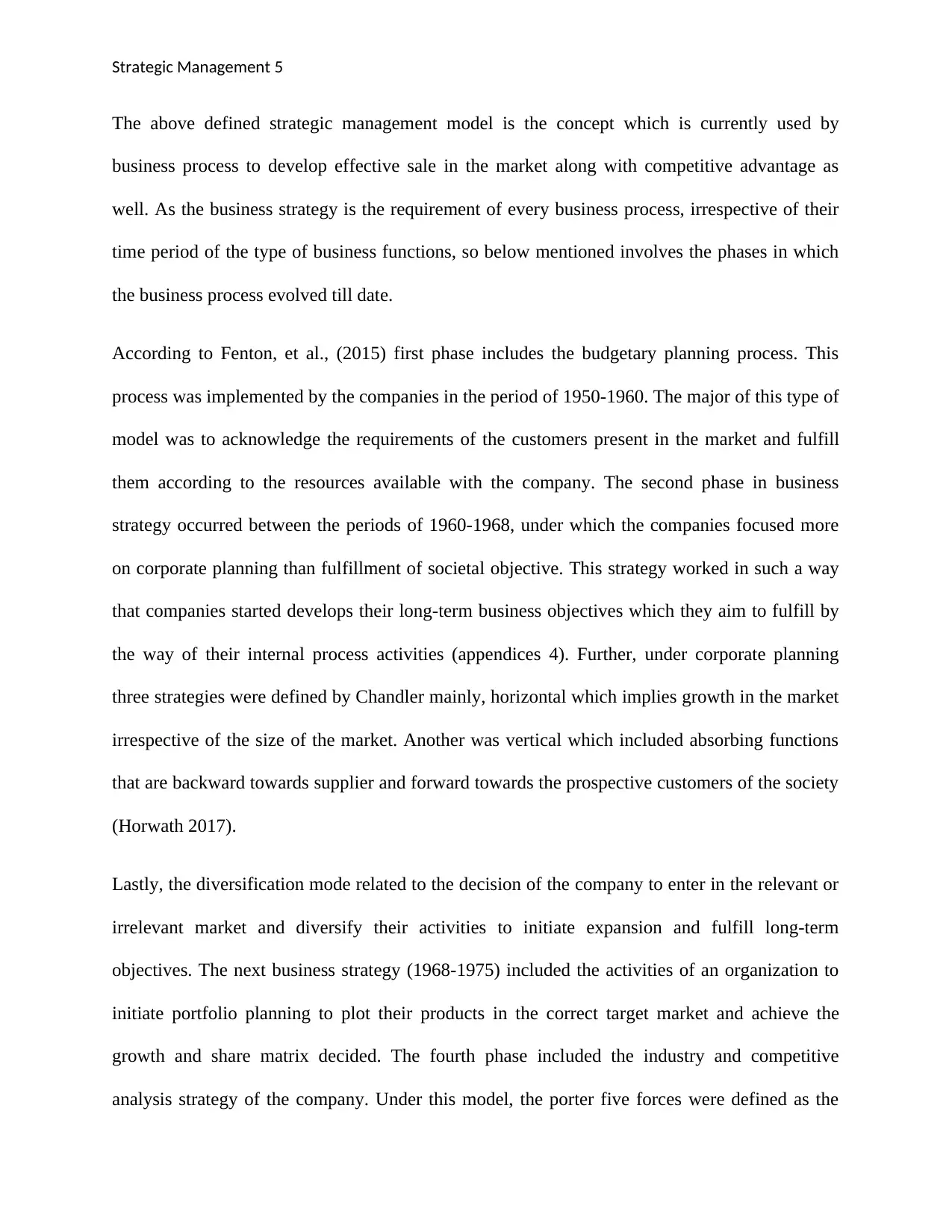
Strategic Management 5
The above defined strategic management model is the concept which is currently used by
business process to develop effective sale in the market along with competitive advantage as
well. As the business strategy is the requirement of every business process, irrespective of their
time period of the type of business functions, so below mentioned involves the phases in which
the business process evolved till date.
According to Fenton, et al., (2015) first phase includes the budgetary planning process. This
process was implemented by the companies in the period of 1950-1960. The major of this type of
model was to acknowledge the requirements of the customers present in the market and fulfill
them according to the resources available with the company. The second phase in business
strategy occurred between the periods of 1960-1968, under which the companies focused more
on corporate planning than fulfillment of societal objective. This strategy worked in such a way
that companies started develops their long-term business objectives which they aim to fulfill by
the way of their internal process activities (appendices 4). Further, under corporate planning
three strategies were defined by Chandler mainly, horizontal which implies growth in the market
irrespective of the size of the market. Another was vertical which included absorbing functions
that are backward towards supplier and forward towards the prospective customers of the society
(Horwath 2017).
Lastly, the diversification mode related to the decision of the company to enter in the relevant or
irrelevant market and diversify their activities to initiate expansion and fulfill long-term
objectives. The next business strategy (1968-1975) included the activities of an organization to
initiate portfolio planning to plot their products in the correct target market and achieve the
growth and share matrix decided. The fourth phase included the industry and competitive
analysis strategy of the company. Under this model, the porter five forces were defined as the
The above defined strategic management model is the concept which is currently used by
business process to develop effective sale in the market along with competitive advantage as
well. As the business strategy is the requirement of every business process, irrespective of their
time period of the type of business functions, so below mentioned involves the phases in which
the business process evolved till date.
According to Fenton, et al., (2015) first phase includes the budgetary planning process. This
process was implemented by the companies in the period of 1950-1960. The major of this type of
model was to acknowledge the requirements of the customers present in the market and fulfill
them according to the resources available with the company. The second phase in business
strategy occurred between the periods of 1960-1968, under which the companies focused more
on corporate planning than fulfillment of societal objective. This strategy worked in such a way
that companies started develops their long-term business objectives which they aim to fulfill by
the way of their internal process activities (appendices 4). Further, under corporate planning
three strategies were defined by Chandler mainly, horizontal which implies growth in the market
irrespective of the size of the market. Another was vertical which included absorbing functions
that are backward towards supplier and forward towards the prospective customers of the society
(Horwath 2017).
Lastly, the diversification mode related to the decision of the company to enter in the relevant or
irrelevant market and diversify their activities to initiate expansion and fulfill long-term
objectives. The next business strategy (1968-1975) included the activities of an organization to
initiate portfolio planning to plot their products in the correct target market and achieve the
growth and share matrix decided. The fourth phase included the industry and competitive
analysis strategy of the company. Under this model, the porter five forces were defined as the
⊘ This is a preview!⊘
Do you want full access?
Subscribe today to unlock all pages.

Trusted by 1+ million students worldwide
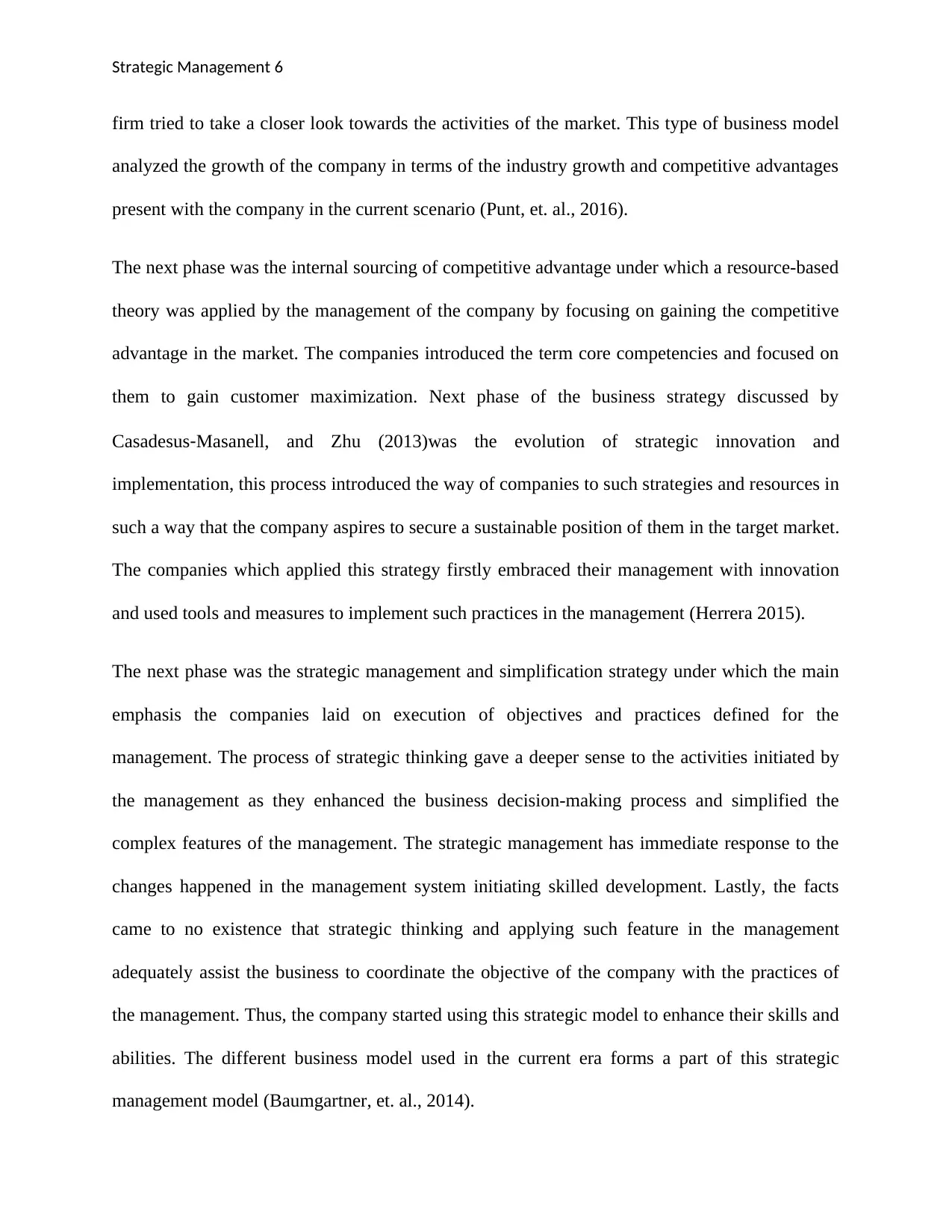
Strategic Management 6
firm tried to take a closer look towards the activities of the market. This type of business model
analyzed the growth of the company in terms of the industry growth and competitive advantages
present with the company in the current scenario (Punt, et. al., 2016).
The next phase was the internal sourcing of competitive advantage under which a resource-based
theory was applied by the management of the company by focusing on gaining the competitive
advantage in the market. The companies introduced the term core competencies and focused on
them to gain customer maximization. Next phase of the business strategy discussed by
Casadesus‐Masanell, and Zhu (2013)was the evolution of strategic innovation and
implementation, this process introduced the way of companies to such strategies and resources in
such a way that the company aspires to secure a sustainable position of them in the target market.
The companies which applied this strategy firstly embraced their management with innovation
and used tools and measures to implement such practices in the management (Herrera 2015).
The next phase was the strategic management and simplification strategy under which the main
emphasis the companies laid on execution of objectives and practices defined for the
management. The process of strategic thinking gave a deeper sense to the activities initiated by
the management as they enhanced the business decision-making process and simplified the
complex features of the management. The strategic management has immediate response to the
changes happened in the management system initiating skilled development. Lastly, the facts
came to no existence that strategic thinking and applying such feature in the management
adequately assist the business to coordinate the objective of the company with the practices of
the management. Thus, the company started using this strategic model to enhance their skills and
abilities. The different business model used in the current era forms a part of this strategic
management model (Baumgartner, et. al., 2014).
firm tried to take a closer look towards the activities of the market. This type of business model
analyzed the growth of the company in terms of the industry growth and competitive advantages
present with the company in the current scenario (Punt, et. al., 2016).
The next phase was the internal sourcing of competitive advantage under which a resource-based
theory was applied by the management of the company by focusing on gaining the competitive
advantage in the market. The companies introduced the term core competencies and focused on
them to gain customer maximization. Next phase of the business strategy discussed by
Casadesus‐Masanell, and Zhu (2013)was the evolution of strategic innovation and
implementation, this process introduced the way of companies to such strategies and resources in
such a way that the company aspires to secure a sustainable position of them in the target market.
The companies which applied this strategy firstly embraced their management with innovation
and used tools and measures to implement such practices in the management (Herrera 2015).
The next phase was the strategic management and simplification strategy under which the main
emphasis the companies laid on execution of objectives and practices defined for the
management. The process of strategic thinking gave a deeper sense to the activities initiated by
the management as they enhanced the business decision-making process and simplified the
complex features of the management. The strategic management has immediate response to the
changes happened in the management system initiating skilled development. Lastly, the facts
came to no existence that strategic thinking and applying such feature in the management
adequately assist the business to coordinate the objective of the company with the practices of
the management. Thus, the company started using this strategic model to enhance their skills and
abilities. The different business model used in the current era forms a part of this strategic
management model (Baumgartner, et. al., 2014).
Paraphrase This Document
Need a fresh take? Get an instant paraphrase of this document with our AI Paraphraser
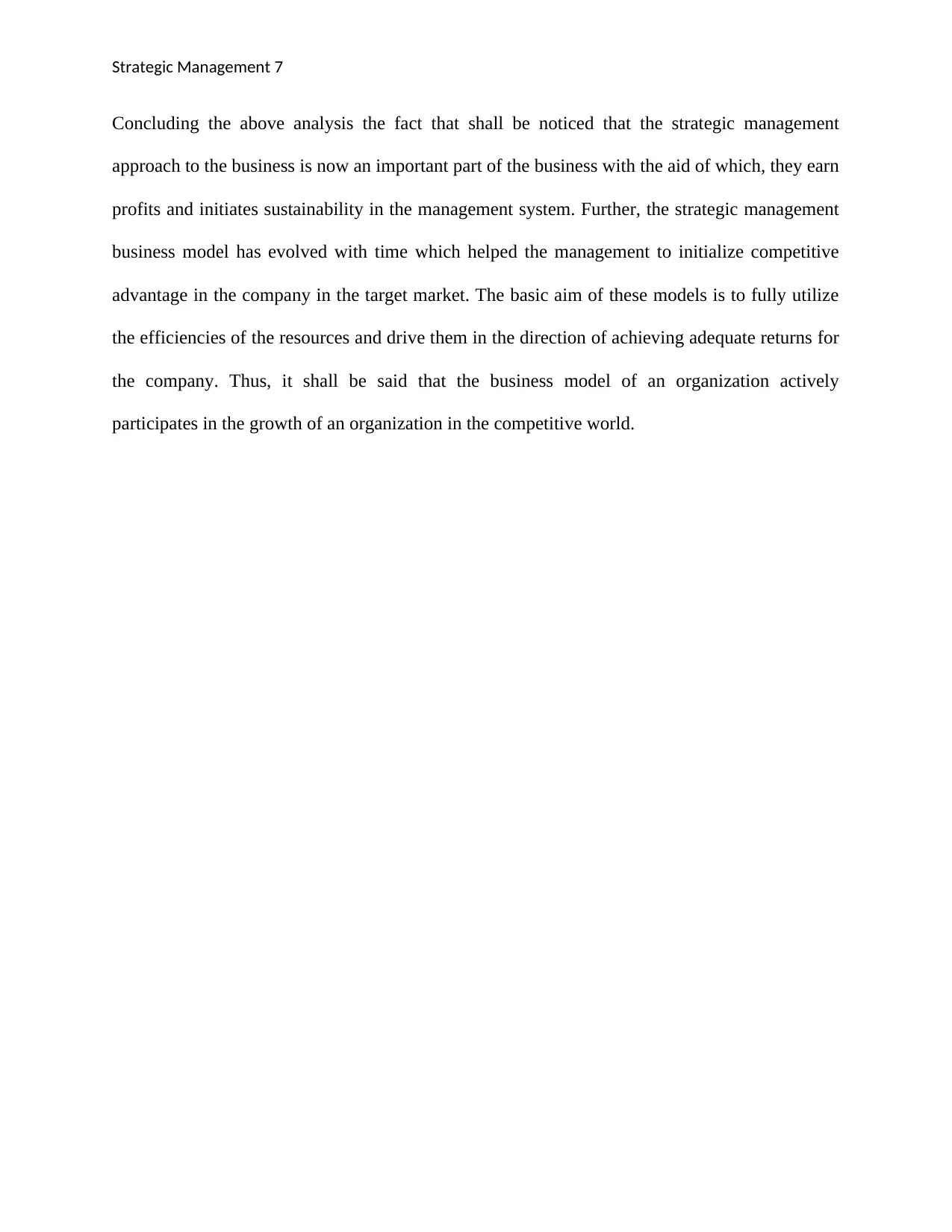
Strategic Management 7
Concluding the above analysis the fact that shall be noticed that the strategic management
approach to the business is now an important part of the business with the aid of which, they earn
profits and initiates sustainability in the management system. Further, the strategic management
business model has evolved with time which helped the management to initialize competitive
advantage in the company in the target market. The basic aim of these models is to fully utilize
the efficiencies of the resources and drive them in the direction of achieving adequate returns for
the company. Thus, it shall be said that the business model of an organization actively
participates in the growth of an organization in the competitive world.
Concluding the above analysis the fact that shall be noticed that the strategic management
approach to the business is now an important part of the business with the aid of which, they earn
profits and initiates sustainability in the management system. Further, the strategic management
business model has evolved with time which helped the management to initialize competitive
advantage in the company in the target market. The basic aim of these models is to fully utilize
the efficiencies of the resources and drive them in the direction of achieving adequate returns for
the company. Thus, it shall be said that the business model of an organization actively
participates in the growth of an organization in the competitive world.
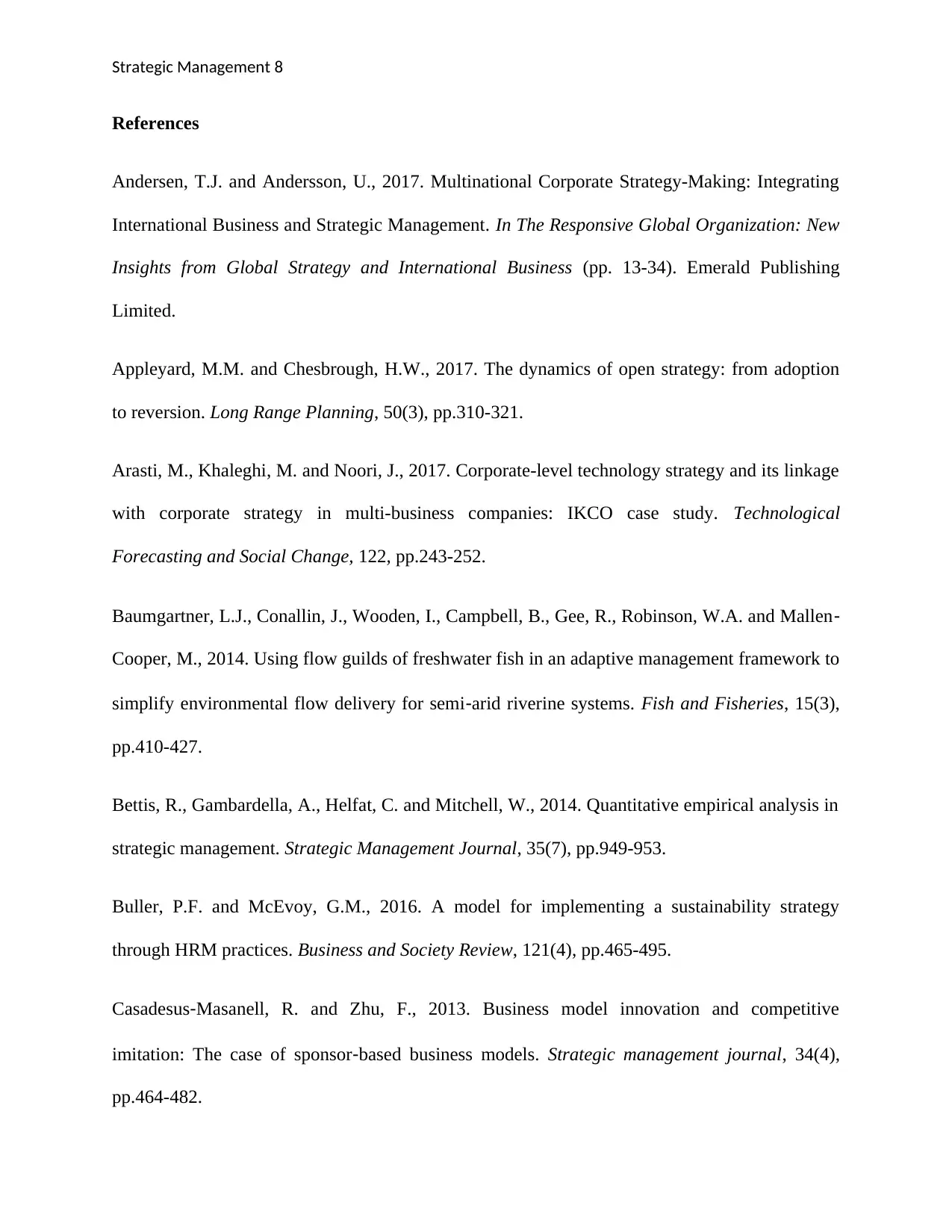
Strategic Management 8
References
Andersen, T.J. and Andersson, U., 2017. Multinational Corporate Strategy-Making: Integrating
International Business and Strategic Management. In The Responsive Global Organization: New
Insights from Global Strategy and International Business (pp. 13-34). Emerald Publishing
Limited.
Appleyard, M.M. and Chesbrough, H.W., 2017. The dynamics of open strategy: from adoption
to reversion. Long Range Planning, 50(3), pp.310-321.
Arasti, M., Khaleghi, M. and Noori, J., 2017. Corporate-level technology strategy and its linkage
with corporate strategy in multi-business companies: IKCO case study. Technological
Forecasting and Social Change, 122, pp.243-252.
Baumgartner, L.J., Conallin, J., Wooden, I., Campbell, B., Gee, R., Robinson, W.A. and Mallen‐
Cooper, M., 2014. Using flow guilds of freshwater fish in an adaptive management framework to
simplify environmental flow delivery for semi‐arid riverine systems. Fish and Fisheries, 15(3),
pp.410-427.
Bettis, R., Gambardella, A., Helfat, C. and Mitchell, W., 2014. Quantitative empirical analysis in
strategic management. Strategic Management Journal, 35(7), pp.949-953.
Buller, P.F. and McEvoy, G.M., 2016. A model for implementing a sustainability strategy
through HRM practices. Business and Society Review, 121(4), pp.465-495.
Casadesus‐Masanell, R. and Zhu, F., 2013. Business model innovation and competitive
imitation: The case of sponsor‐based business models. Strategic management journal, 34(4),
pp.464-482.
References
Andersen, T.J. and Andersson, U., 2017. Multinational Corporate Strategy-Making: Integrating
International Business and Strategic Management. In The Responsive Global Organization: New
Insights from Global Strategy and International Business (pp. 13-34). Emerald Publishing
Limited.
Appleyard, M.M. and Chesbrough, H.W., 2017. The dynamics of open strategy: from adoption
to reversion. Long Range Planning, 50(3), pp.310-321.
Arasti, M., Khaleghi, M. and Noori, J., 2017. Corporate-level technology strategy and its linkage
with corporate strategy in multi-business companies: IKCO case study. Technological
Forecasting and Social Change, 122, pp.243-252.
Baumgartner, L.J., Conallin, J., Wooden, I., Campbell, B., Gee, R., Robinson, W.A. and Mallen‐
Cooper, M., 2014. Using flow guilds of freshwater fish in an adaptive management framework to
simplify environmental flow delivery for semi‐arid riverine systems. Fish and Fisheries, 15(3),
pp.410-427.
Bettis, R., Gambardella, A., Helfat, C. and Mitchell, W., 2014. Quantitative empirical analysis in
strategic management. Strategic Management Journal, 35(7), pp.949-953.
Buller, P.F. and McEvoy, G.M., 2016. A model for implementing a sustainability strategy
through HRM practices. Business and Society Review, 121(4), pp.465-495.
Casadesus‐Masanell, R. and Zhu, F., 2013. Business model innovation and competitive
imitation: The case of sponsor‐based business models. Strategic management journal, 34(4),
pp.464-482.
⊘ This is a preview!⊘
Do you want full access?
Subscribe today to unlock all pages.

Trusted by 1+ million students worldwide
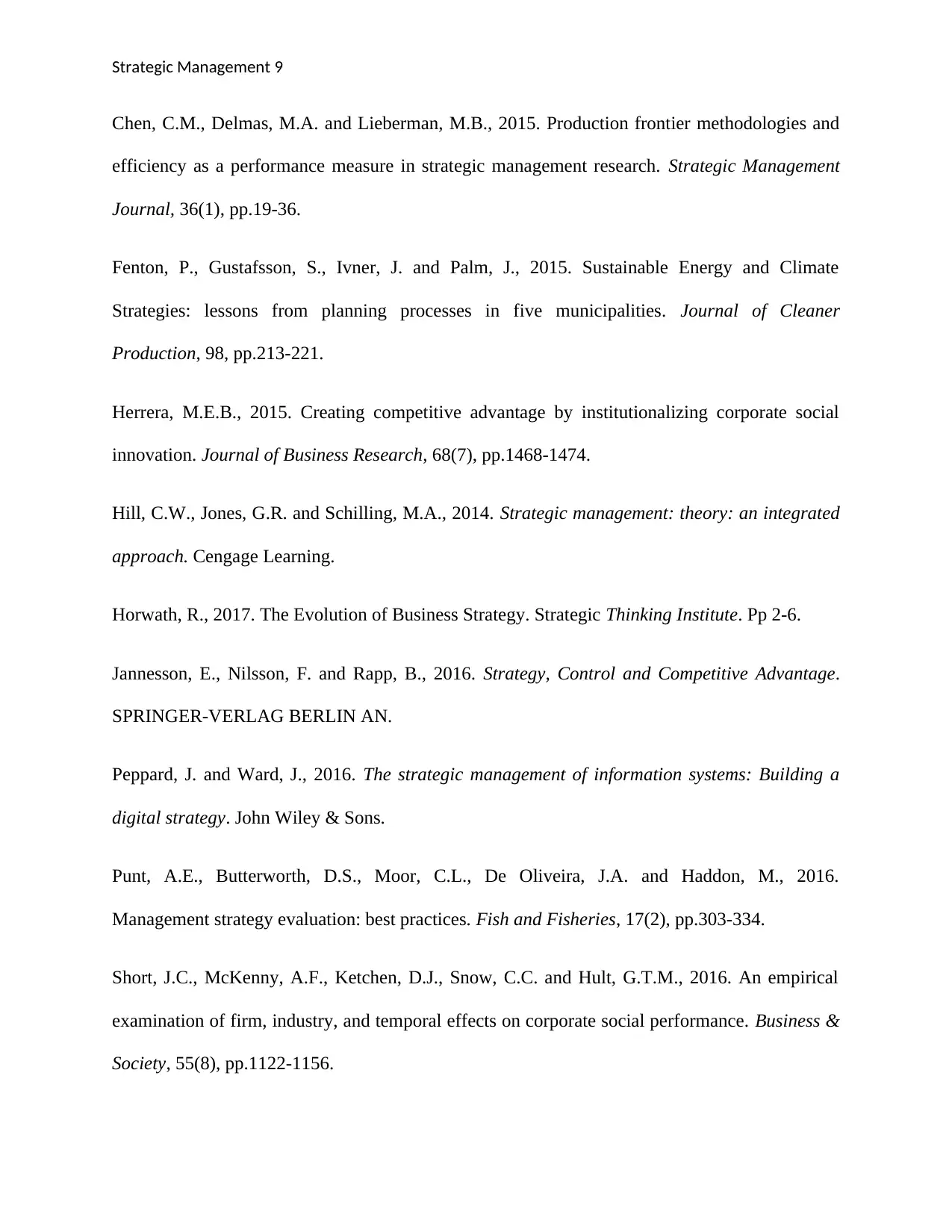
Strategic Management 9
Chen, C.M., Delmas, M.A. and Lieberman, M.B., 2015. Production frontier methodologies and
efficiency as a performance measure in strategic management research. Strategic Management
Journal, 36(1), pp.19-36.
Fenton, P., Gustafsson, S., Ivner, J. and Palm, J., 2015. Sustainable Energy and Climate
Strategies: lessons from planning processes in five municipalities. Journal of Cleaner
Production, 98, pp.213-221.
Herrera, M.E.B., 2015. Creating competitive advantage by institutionalizing corporate social
innovation. Journal of Business Research, 68(7), pp.1468-1474.
Hill, C.W., Jones, G.R. and Schilling, M.A., 2014. Strategic management: theory: an integrated
approach. Cengage Learning.
Horwath, R., 2017. The Evolution of Business Strategy. Strategic Thinking Institute. Pp 2-6.
Jannesson, E., Nilsson, F. and Rapp, B., 2016. Strategy, Control and Competitive Advantage.
SPRINGER-VERLAG BERLIN AN.
Peppard, J. and Ward, J., 2016. The strategic management of information systems: Building a
digital strategy. John Wiley & Sons.
Punt, A.E., Butterworth, D.S., Moor, C.L., De Oliveira, J.A. and Haddon, M., 2016.
Management strategy evaluation: best practices. Fish and Fisheries, 17(2), pp.303-334.
Short, J.C., McKenny, A.F., Ketchen, D.J., Snow, C.C. and Hult, G.T.M., 2016. An empirical
examination of firm, industry, and temporal effects on corporate social performance. Business &
Society, 55(8), pp.1122-1156.
Chen, C.M., Delmas, M.A. and Lieberman, M.B., 2015. Production frontier methodologies and
efficiency as a performance measure in strategic management research. Strategic Management
Journal, 36(1), pp.19-36.
Fenton, P., Gustafsson, S., Ivner, J. and Palm, J., 2015. Sustainable Energy and Climate
Strategies: lessons from planning processes in five municipalities. Journal of Cleaner
Production, 98, pp.213-221.
Herrera, M.E.B., 2015. Creating competitive advantage by institutionalizing corporate social
innovation. Journal of Business Research, 68(7), pp.1468-1474.
Hill, C.W., Jones, G.R. and Schilling, M.A., 2014. Strategic management: theory: an integrated
approach. Cengage Learning.
Horwath, R., 2017. The Evolution of Business Strategy. Strategic Thinking Institute. Pp 2-6.
Jannesson, E., Nilsson, F. and Rapp, B., 2016. Strategy, Control and Competitive Advantage.
SPRINGER-VERLAG BERLIN AN.
Peppard, J. and Ward, J., 2016. The strategic management of information systems: Building a
digital strategy. John Wiley & Sons.
Punt, A.E., Butterworth, D.S., Moor, C.L., De Oliveira, J.A. and Haddon, M., 2016.
Management strategy evaluation: best practices. Fish and Fisheries, 17(2), pp.303-334.
Short, J.C., McKenny, A.F., Ketchen, D.J., Snow, C.C. and Hult, G.T.M., 2016. An empirical
examination of firm, industry, and temporal effects on corporate social performance. Business &
Society, 55(8), pp.1122-1156.
Paraphrase This Document
Need a fresh take? Get an instant paraphrase of this document with our AI Paraphraser
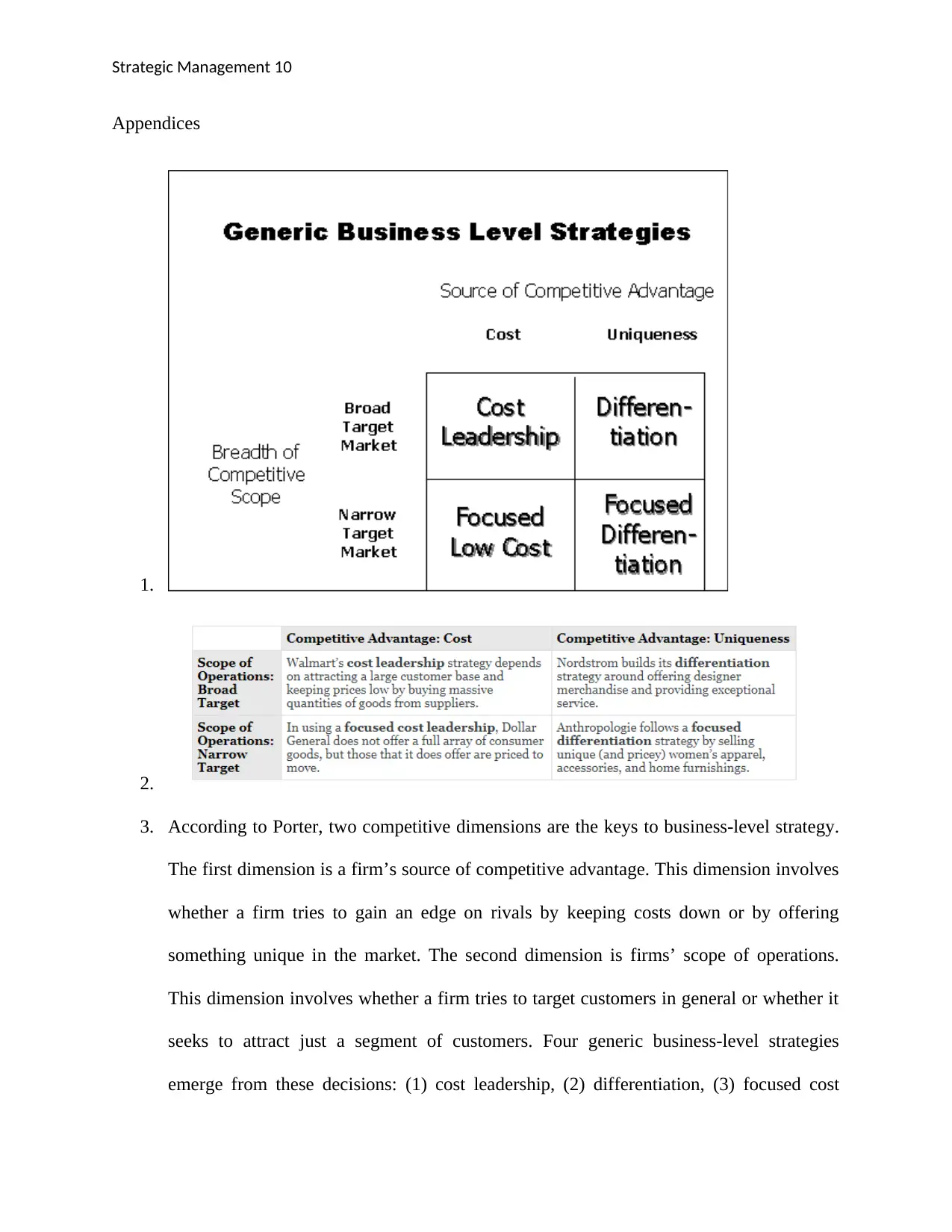
Strategic Management 10
Appendices
1.
2.
3. According to Porter, two competitive dimensions are the keys to business-level strategy.
The first dimension is a firm’s source of competitive advantage. This dimension involves
whether a firm tries to gain an edge on rivals by keeping costs down or by offering
something unique in the market. The second dimension is firms’ scope of operations.
This dimension involves whether a firm tries to target customers in general or whether it
seeks to attract just a segment of customers. Four generic business-level strategies
emerge from these decisions: (1) cost leadership, (2) differentiation, (3) focused cost
Appendices
1.
2.
3. According to Porter, two competitive dimensions are the keys to business-level strategy.
The first dimension is a firm’s source of competitive advantage. This dimension involves
whether a firm tries to gain an edge on rivals by keeping costs down or by offering
something unique in the market. The second dimension is firms’ scope of operations.
This dimension involves whether a firm tries to target customers in general or whether it
seeks to attract just a segment of customers. Four generic business-level strategies
emerge from these decisions: (1) cost leadership, (2) differentiation, (3) focused cost
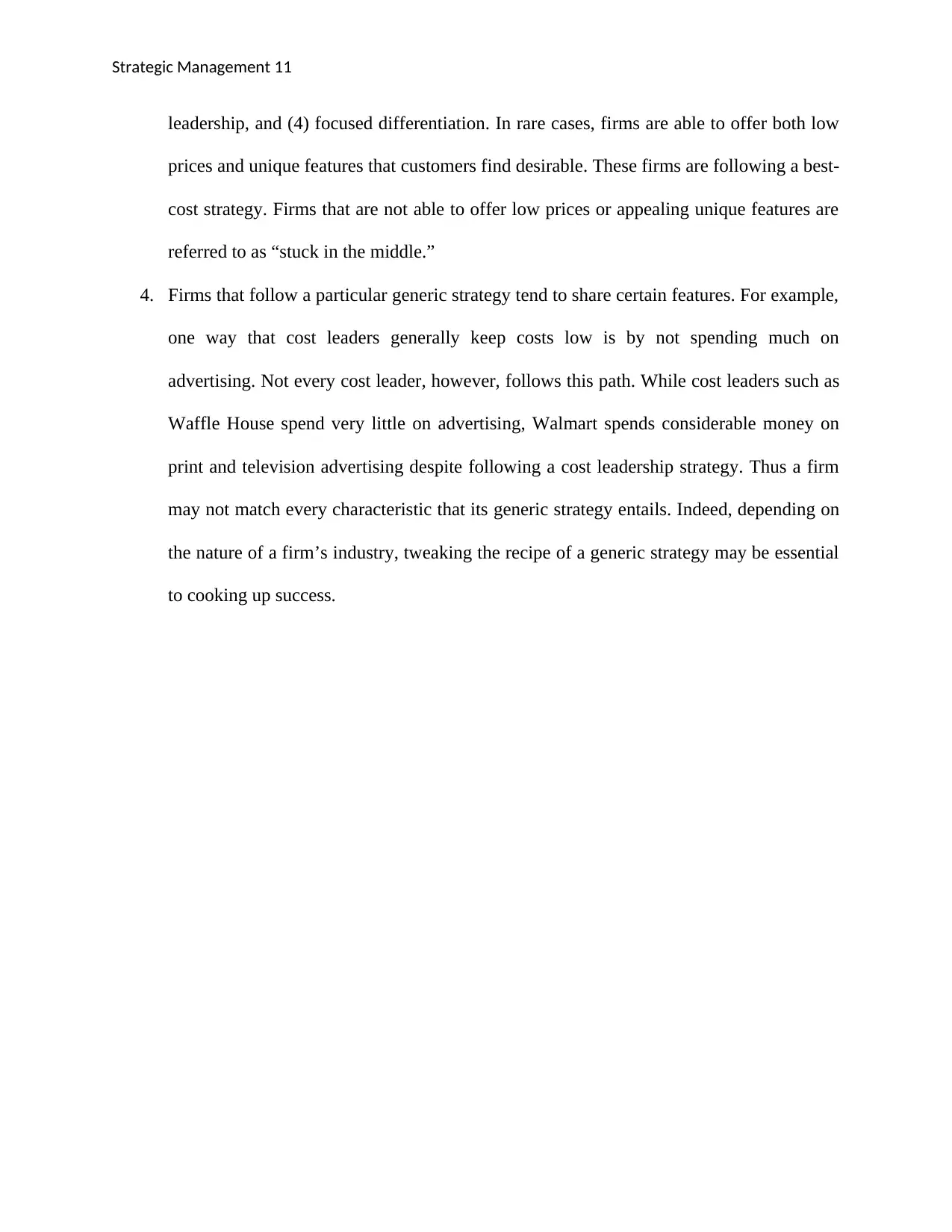
Strategic Management 11
leadership, and (4) focused differentiation. In rare cases, firms are able to offer both low
prices and unique features that customers find desirable. These firms are following a best-
cost strategy. Firms that are not able to offer low prices or appealing unique features are
referred to as “stuck in the middle.”
4. Firms that follow a particular generic strategy tend to share certain features. For example,
one way that cost leaders generally keep costs low is by not spending much on
advertising. Not every cost leader, however, follows this path. While cost leaders such as
Waffle House spend very little on advertising, Walmart spends considerable money on
print and television advertising despite following a cost leadership strategy. Thus a firm
may not match every characteristic that its generic strategy entails. Indeed, depending on
the nature of a firm’s industry, tweaking the recipe of a generic strategy may be essential
to cooking up success.
leadership, and (4) focused differentiation. In rare cases, firms are able to offer both low
prices and unique features that customers find desirable. These firms are following a best-
cost strategy. Firms that are not able to offer low prices or appealing unique features are
referred to as “stuck in the middle.”
4. Firms that follow a particular generic strategy tend to share certain features. For example,
one way that cost leaders generally keep costs low is by not spending much on
advertising. Not every cost leader, however, follows this path. While cost leaders such as
Waffle House spend very little on advertising, Walmart spends considerable money on
print and television advertising despite following a cost leadership strategy. Thus a firm
may not match every characteristic that its generic strategy entails. Indeed, depending on
the nature of a firm’s industry, tweaking the recipe of a generic strategy may be essential
to cooking up success.
⊘ This is a preview!⊘
Do you want full access?
Subscribe today to unlock all pages.

Trusted by 1+ million students worldwide
1 out of 12
Related Documents
Your All-in-One AI-Powered Toolkit for Academic Success.
+13062052269
info@desklib.com
Available 24*7 on WhatsApp / Email
![[object Object]](/_next/static/media/star-bottom.7253800d.svg)
Unlock your academic potential
Copyright © 2020–2025 A2Z Services. All Rights Reserved. Developed and managed by ZUCOL.





